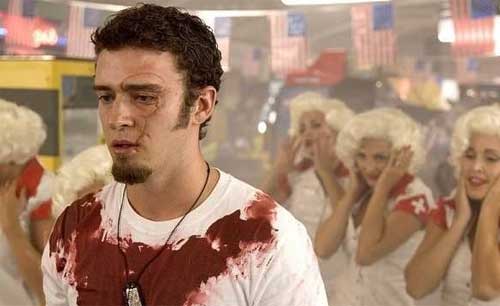Title: Troll Hunter
Released: 2010
Starring: Otto Jespersen, Hans Morten Hansen, Tomas Alf Larsen, Johanna Mørck, Knut Nærum, Robert Stoltenberg, Glenn Erland Tosterud
Plot: Student film makers, Thomas,
Johanna and cameraman Kalle are making a documentary about a suspected bear
poacher Hans (Jespersen). Soon however they discover what Hans is hunting is
not bears but trolls. Following this revelation the group choose to follow Hans
as he goes about his work.
Shot in a similar style to “Man Bites Dog” and makes it kind
of a shame that they didn’t go for a cheeky nod and call this “Man Hunts
Troll”. Shot in a documentary style, it is one faithfully maintained throughout
aswell as one which proves to be highly effective as the students discover the
truth about Hans and soon find themselves joining him as he goes about his work
for the Troll Security Agency ensuring that trolls don’t enter into populated
areas, something which seems to be happening more regularly Hans reveals and
the reasons why he attempts to discover over the course of the film, all the
while with the students in tow while still finding time to fill in the gaps as
the students hold spontaneous interview sessions between hunts while educating
the group on the behaviour and general troll biology.
Hans generally is a great central character, especially as
he is played as just another bored government employee who just happens to hunt
troll for a living and in many ways bringing back for myself memories of the
Masaru Daisato in “Big Man Japan”. Here Øvredal
really shows an eye for details, from Hans armoured truck which wouldn’t look
out of place in “Mad Max” through to his hunt equipment ranging from the UV
lights which cause the trolls to turn to stone or explode (depending on their
age) through to his clunky suit of
armour he wheels out when required to get a blood sample from one particularly
angry troll. Han’s even has developed his own brand of Troll stink to allow
himself and the film crew to disguise themselves, though for some reason
nothing can overpower the scent of a Christian which for some reason trolls are
especially attracted to. Over the course of the film we also get to meet some
of the other members of the Troll security agency such as Finn (Hansen) who is
less than happy with the students threatening to expose this secret
organisation, while generally covering for troll attacks by making them look
like bear attacks.
Another film which is certainly worth noting while drawing
comparisons would be “Jurassic Park” which when it comes to the troll footage
seems to have been an inspiration, as director Øvredal
makes real effort to shot the various species of troll with a style none to
dissimilar to a nature film, as especially seen in the first encounter we have
with these mythical creatures with said creature being shown majestically
making its way through the woods as it tries to locate them with its multiple
heads. Here we see none of the usual camera jerking as instead he maintains a
sustained and focus camera shot as he tracks the creature, were as most films
would shot these same sequences with jerky camera movement and out of focus
shots. Its of course these sequences were the strength of the film lies as Øvredal
ensures that each troll encounter is memorable building on each encounter to
the finale show down with a towering Jotnar troll.
Unsurprisingly the troll sequences
form the real highlights of the film with Øvredal showing a keen eye for
directing this action, while finding new ways to mix up how he shows each of
these sequences, from skilfully cranking up the tension as the group find
themselves in a troll infested cave, while their escape in Han’s truck from the
Jotnar troll is truly a standout sequence and one which certainly benefits from
watching the film on a large screen, especially as it only adds to the visual
illusion of riding with the group as they make thier escape.
While the film is unquestionably at its strongest when the
trolls are on the screen, or the group are learning more about Hans and his
trade, the is still a fair amount of filler especially during the third quarter
were we get to see perhaps alittle too much of the unquestionably picturesque
Norwegian landscape, but used to such extent it does frequently give the
feeling of the film slipping into a video postcard. As such the film perhaps
could have benefited from trimming some of this fat of the run time or even
another encounter which could have been found during these segments. The film
equally suffers with several of its more regionlised moments humour, while the
sheer amount of Norwegian comedians rounding out the cast (or so Wikipedia
tells me) I have to wonder if this film is funnier to Norwegian audiences than
it is to English speaking audiences??
While it might have its flaws there is still fun to be had
here, especially as Øvredal goes more for spectacle
than scares, but then the found footage genre has hardly been renown for
producing such scares. Øvredal through has truly brought his own style to the
genre and it is only all the stronger that he chooses to not stick to the
established rules of the genre. Ultimately though this is a fun ride while the
originally ensure that this is worth giving a curious watch.
























